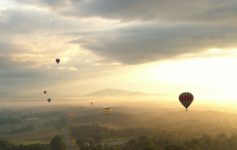About two weeks ago I had the opportunity to attend a presentation by Tom Rosenbauer, host of the Orvis Fly Fishing Podcasts, acclaimed author, and Marketing Director for Orvis Rod & Tackle. The event was held at the Cambridge Hotel, and was sponsored by the Batten Kill Watershed Alliance. Rosenbauer has been fly fishing for over 35 years, and was tying flies commercially at age 14 – obviously, he knows his stuff.
Mr. Rosenbauer spoke about the way that most fishermen are so obsessed with catching the biggest, best fish that they lose sight of what fishing is really about. So, rather than stand on the bank of trophy waters fishing alongside 25 other people that want to catch the 30″ Brown Trout, he has taken to the small, remote streams. You know, the ones you have to look for.
Is fly fishing really about catching the most fish, or the biggest fish? No. Fly fishing is about learning how fish behave. It’s about learning how to trick a fish into thinking a little ball of feathers and hair is actually something edible. It’s about sneaking up to the stream and attempting to drop a fly near where a fish might be holding, and doing it unnoticed. And furthermore, it’s about the feeling you get when you land a fish, regardless of the length and weight of said fish. As far as I am concerned, fishing a river where you catch a king salmon on every other cast is not fishing at all – it’s boring.
I listened closely to what Rosenbauer was saying. Fishing a small stream doesn’t require 3 boxes full of flies or a 6 foot superfine glass rod, and you don’t need three friends to come with you. He showed us a few different casting methods to use, a side-arm cast, roll-cast and a bow & arrow type cast for really tight spots. Rosenbauer also stated that most of the time, the only fly needed to catch trout on a small stream is a Parachute Adams somewhere between size 14 and 20. He showed us where to place our flies in the stream (or at least attempt to) and also taught us how to find these small streams using – not google earth, but a good, old-fashioned topographical map.
I took all of his advice, bought a few parachute adams and some dry-shake to keep my flies floating and headed up to one of my favorite streams to try to land a brookie or two. The stream I was fishing isn’t too small, about 15-20 feet wide in most spots. I got to the the stream at about 6:00pm, and after figuring out a problem with the connection between leader and line (knot tag was catching my tippet) I was casting my flies adequately enough to really start approaching where I thought the fish might be. After about an hour I came upon this one hole, between two rocks and just below a riffle of faster moving water. I regret not taking a photo of this pool, but I don’t really want to get in the habit of broadcasting all of my fishing spots on the Internet.
I sat there looking at the pool for five or ten minutes before I attempted to cast into it. After a couple tries, I put my fly right in between the rocks, waited a bit.. and splash! A fish tried to take my fly, but either missed or spit it out immediately! I waited a minute before casting back into that particular pool, casting around to some other areas for a bit. A few minutes later I turned back to the original hole. I cast my fly again, almost perfectly upstream from the rocks, so that the fly could naturally flow into the pool, and when it did.. sure enough, wham! This time the fish made sure to hit the fly , and hit it hard. Unfortunately I failed in setting the hook, and the fish was off.
I didn’t have much luck for the rest of the evening, and headed home around 8:30pm as it was starting to get difficult to keep my eye on the fly. I didn’t land a fish, I didn’t even get the chance to play a fish. I got two bites, probably from the same fish, and missed them both. However, I did not waste my time. I was not disappointed. I was happy. I thought that this fishing trip went fairly well considering my experience and ability. I had actually tricked a trout into thinking that my fly, floating there on the surface of the stream, was food! Next time I will be sure to pay a little closer attention when setting the hook. Honestly though, I wasn’t even thinking about setting the hook last time, I was just thinking about how I can get a fish to take my fly.. Lesson learned!


Nice post, Scott!
You are a true fisherman. No need to catch fish to have a great time fishing.
Yes nice post Scott. Good fishing,each outing should bring us something in terms of expierience, a hit, hooking a fish and loosing it. I’ve been fishing for 30 plus years in all dfferent waters for most species of fish and some of my most memorable fish were one’s that I lost. The excitement of the fight and what I learned from that encounter. Or actually landing one or more. I also like the way that you remember and document your fishing outings and talk positive about your fishing.May I suggest keeping a diary, maybe you already do. I keep a log book with the date, air temp,water temp,weather like rainy,windy,sunny. The water calm, choppy, low or high. Write special notations to yourself and even draw sketches or take pictures for yourself. What you used,a fly/ what kind and where.I do this so that I can compare it the following years. I try to remember that it’s called fishing not catching. And I would say as long as your out there learning and enjoying yourself it’s a good day. Keep up the good work and enjoy. Tight lines Brian
Thanks for the comments guys! Brian, great idea.. I am definitely going to start keeping a log of my fishing outings – noting temperatures, weather, what worked, what didn’t. Then I won’t be starting from square one next spring. I always say “the catching could be better, but the fishing is great!”